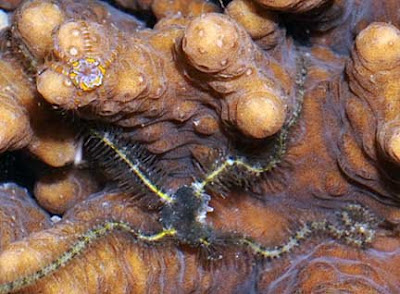4am and we're off to St. John's Island! This well developed island still has some narrow natural reefs with a variety of hard corals. It's great to visit a reef at night as the animals seem more lively then. Hard corals are actually colonial animals, each colony made up of many individual polyps. At night, many hard coral polyps are fully extended, showing their beautiful tentacles.
Hard corals are actually colonial animals, each colony made up of many individual polyps. At night, many hard coral polyps are fully extended, showing their beautiful tentacles. Here's a closer look at one of the polyps in this hard coral colony. Each polyp in a hard coral produces a hard skeleton. The different shapes and arrangement of these tiny skeletons produce the delightful patterns of hard corals.
Here's a closer look at one of the polyps in this hard coral colony. Each polyp in a hard coral produces a hard skeleton. The different shapes and arrangement of these tiny skeletons produce the delightful patterns of hard corals.
Here's some of the kinds of hard corals we saw today.
Disk corals (Turbinaria sp.) are quite regularly encountered on our reefs. The colony is plate-like and generally forms disks. This particular kind of Turbinaria has large polyps with many long tentacles and the colony plate is rather thick.
This particular kind of Turbinaria has large polyps with many long tentacles and the colony plate is rather thick. Another commonly seen colony has thinner disks and smaller polyps with fewer tentacles.
Another commonly seen colony has thinner disks and smaller polyps with fewer tentacles. Yet another kind has plates that hug the surface. While the colony may be quite large, the polyps are really tiny with few tentacles. This kind is generally only seen in good reefs.
Yet another kind has plates that hug the surface. While the colony may be quite large, the polyps are really tiny with few tentacles. This kind is generally only seen in good reefs. Pocillopora corals (Pocillopora sp.) are also regularly seen. The colony is branching, and the tiny polyps have white rounded tips.
Pocillopora corals (Pocillopora sp.) are also regularly seen. The colony is branching, and the tiny polyps have white rounded tips. Branching Psammocora corals (Psammocora sp.) are also often seen. In these, the tentacles are short and pointed. Branching corals are like underwater trees, providing hiding places for all kinds of tiny animals such as this little crab.
Branching Psammocora corals (Psammocora sp.) are also often seen. In these, the tentacles are short and pointed. Branching corals are like underwater trees, providing hiding places for all kinds of tiny animals such as this little crab. There are also Psammocora sp. that form boulder shaped colonies. This species is identified by the tiny petal-shaped holes in the skeleton.
There are also Psammocora sp. that form boulder shaped colonies. This species is identified by the tiny petal-shaped holes in the skeleton. These holes are not so obvious when the tiny tentacles are extended.
These holes are not so obvious when the tiny tentacles are extended. Here is another pretty coral that is sometimes seen on our reefs. I don't know what kind of hard coral this is.
Here is another pretty coral that is sometimes seen on our reefs. I don't know what kind of hard coral this is. Brain corals (Family Mussidae) are also seen on good reefs. In these, the polyps create skeletons with meandering walls.
Brain corals (Family Mussidae) are also seen on good reefs. In these, the polyps create skeletons with meandering walls. Unlike most other hard corals, these mushroom corals (Family Fungidae) are solitary polyps. And adults lie unattached to the surface. There was a cluster of these beautiful animals in the middle of the reef.
Unlike most other hard corals, these mushroom corals (Family Fungidae) are solitary polyps. And adults lie unattached to the surface. There was a cluster of these beautiful animals in the middle of the reef.
This narrow reef also had some nice surprises. I seldom see this Hydnophora sp. hard coral. The colony has polyps that form conical skeletons.
I seldom see this Hydnophora sp. hard coral. The colony has polyps that form conical skeletons. Another beautiful and rarely encountered hard coral is this plate-like Pachyseris sp. with elegant ridges in its skeleton.
Another beautiful and rarely encountered hard coral is this plate-like Pachyseris sp. with elegant ridges in its skeleton.
There were also lots of large leathery soft corals on the shores. These are colonies too of tiny polyps. But the polyps share a leathery tissue instead of building hard skeletons. Here's a view of the shore at sunrise with the city just a few minutes away.
Here's a view of the shore at sunrise with the city just a few minutes away. This leathery soft coral is one that I've seen sometimes. Today I took a real close look at them and noticed there were lots of tiny brittle stars on the soft coral!
This leathery soft coral is one that I've seen sometimes. Today I took a real close look at them and noticed there were lots of tiny brittle stars on the soft coral! Including some that were a little larger.
Including some that were a little larger. Indeed, a good reef with their soft and hard corals provides shelter and food for a vast variety of animals. Here's more about some of the reef creatures we saw today.
Indeed, a good reef with their soft and hard corals provides shelter and food for a vast variety of animals. Here's more about some of the reef creatures we saw today.
Aug 2, 2008
Living Reefs of St. John's Island
posted by
Ria Tan
at
3:58 PM
![]()
labels: st. john's island
Subscribe to:
Post Comments (Atom)

No comments:
Post a Comment